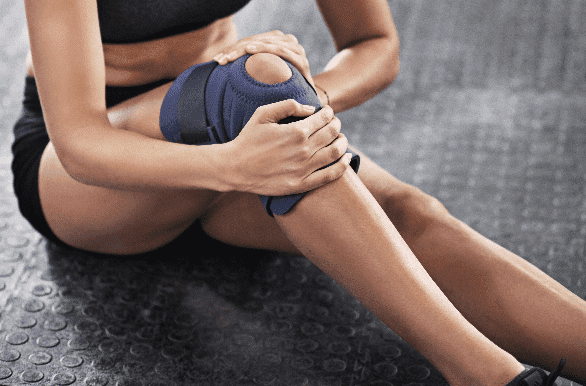Fitness and Performance
Five common reasons for inside knee pain

Pain on the inside of the knee (medial knee pain) can happen to anyone, whether you’re a runner, footballer or casual gym-goer. Today, Bodyset Senior MSK Physiotherapist, Matt looks in detail at five of the most common causes of medial knee pain. He also shares tips on how to avoid a knee injury and what to do if you it happens to you.
Medial collateral ligament strain
The MCL is one of the four major ligaments of the knee. The others are the ACL (anterior), PCL (posterior) and LCL (lateral). The role of these ligaments is to maintain the stability of the knee joint and prevent forces from moving the thigh and shin bones apart. The MCL runs vertically along the inside of the knee; from the thigh bone (femur), across the knee joint to the shin bone (tibia). Ligament injuries often occur due to an obvious mechanism of injury, such as a twist or a force hitting the outside of the knee (for example a tackle in football). Dependent on the severity of the injury, there may be swelling, bruising and pain on the inside of the knee. You may also experience difficulty walking and a feeling of instability in the knee.
Medial meniscus injury
The menisci are crescent-shaped discs of cartilage in the knee joint. The medial meniscus is located on the inside of the knee and the lateral on the outside. An injury can occur due to a specific movement, such as the knee twisting. The resulting tears in the meniscus then ‘catch’ when bending and straightening your knee, resulting in pain. Injuries can also occur due to wear and tear over time; this is called a chronic meniscus injury. A medial meniscus injury may cause any of the following symptoms: pain on the inside of the knee; a painful click when bending the knee; a feeling of your knee being ‘locked’; swelling and stiffness.
Wear and tear
Like all joints, wear and tear from repetitive use and age takes place in the knee. Degeneration occurs on the joint surfaces, causing the tissues that usually allow the joint to move freely to become painful. This wear and tear can be accelerated in people who are extremely active, such as athletes. However, sedentary people who do little or no exercise can also experience an accelerated rate of degeneration. This underlines the importance of regular exercise to reduce injuries. Wear and tear of the knee may cause pain; stiffness; swelling; difficulty walking; climbing stairs; and getting up from a chair or bed.
Pes anserine bursitis
The bursa are fluid-filled sacs in the body that help to reduce friction during movement. Bursitis is an inflammation of these bursa. The pes anserine is an insertion of the tendons of three muscles on the inside of the knee – just below the knee joint. Pes anserine bursitis can be caused by many factors including: sports such as football and basketball with repetitive turning movements; a sudden increase in physical activity; muscle imbalances; or an underlying knee issue. The primary symptom of pes anserine bursitis is pain on the inside of the knee. This is often felt when bending and straightening your leg, as well as going up and downstairs. You may also feel weakness around the knee and notice swelling.
Plica syndrome
Plica are folds of thin tissue in the knee. They form part of the joint membrane which allows friction-free movement. Only around 50% of people have them, meaning that plica syndrome is relatively uncommon. You may feel tenderness in the inside of your knee, especially when it is touched, a painful clicking or a snap when your knee bends. There is also the positive duvet test – literally a test using a duvet! If your knees are painful when lying in bed on your side, place a duvet between your knees. If there is a reduction in symptoms it will likely be down to plica syndrome.
What can you do to reduce knee pain?
Although some injuries are unavoidable, such as sports-inflicted MCL injuries, there are many things you can do many things to reduce the chance of them occurring. The best method is exercise, specifically strengthening the muscles around the knee. Exercises such as squats or leg press in the gym are extremely effective in preventing knee pain. If you begin to suffer from pain on the inside of your knee it is important to stop the aggravating activities as much as possible. You can also use an ice compress, elevate your leg when resting and use painkillers as necessary.
What can we do to help?
If you are experiencing reoccurring knee pain or think you have injured your knee then we advise that you seek help from a physiotherapist. After thorough assessment, your physio will be able to identify the issue and advise a treatment plan to get you back to doing what you love without pain. They’ll also help you with ways in which to prevent any further medial knee issues.